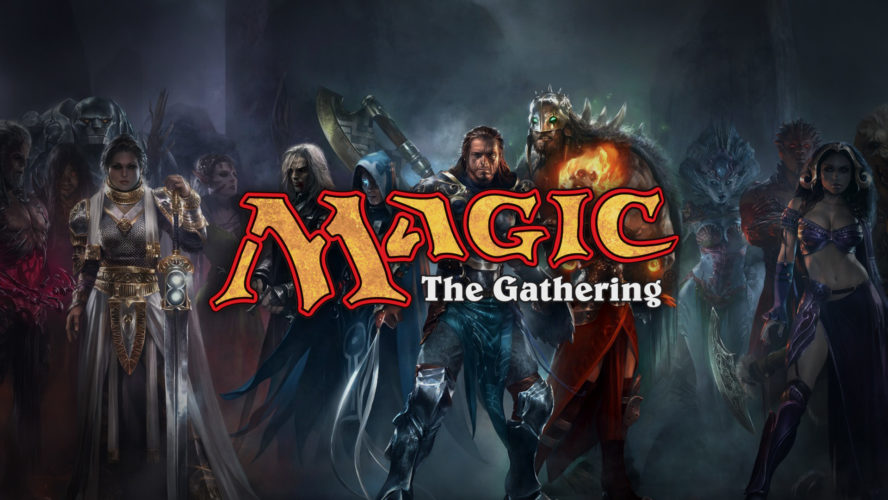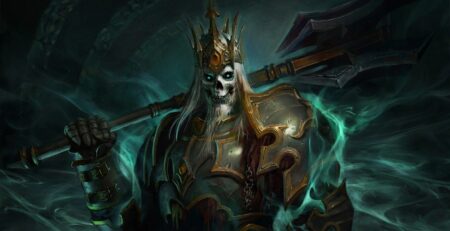
Magic: The Gathering has been around for decades and is the first trading card game, released in 1993, designed by Richard Garfield and published by Wizards of the Coast. With so many trading card games (TCG) and collectible card games (CCG), you more than likely have heard of or seen Magic: The Gathering in action in some capacity. Learning to play, remembering mechanics, and finding a community may seem daunting but have no fear fledgling Planeswalker, this article will have you on your way and hopefully diving headfirst into the wonderful world of Magic.
Now, Magic: The Gathering is so much more than awesome-looking cards and dominating your opponents in matches. It’s such an immersive game with lore and characters that allows you to use your imagination, dunking yourself into the world of Magic. While you may be sitting at a table looking at your new collection or having your first match with a stranger or a friend, know that you and that other player are known as Planeswalkers. Planeswalkers are the equivalent of powerful sorcerers. Your deck of cards is your spells ranging from creatures, cause and effect cards, and other Planeswalkers to aid you in battle. While each player will have an eclectic plethora of spells at their disposal, each Planeswalker specializes in a certain color of Mana. Mana is the class of magic you’re using and they come in different colors. The colors are as follows: White, Blue, Black, Red, Green. Each Mana is unique and has its own playstyle.
White Mana constitutes peace, order, and light; many spells in a White Deck will have weak monsters and allow you to call upon the help of soldiers. But there are plenty of spells to make your creatures powerful, protect your allies from damage or spells, and even heal your creatures. Blue Mana consists of trickery and manipulation. Many players using this kind of deck will look to control what you can do and what spells you can cast. Many times, Blue Mana players will circumvent damage or spells meant for them right back at you. Blue Mana spells and creatures are known to take control of their enemies for a period of time.
Black Mana represents power, death, and corruption. When facing an opponent using spells and creatures from this deck, you will notice an undead theme. Creatures will look grotesque varying from ghosts, vampires, and zombies. These decks will have spells that will blatantly seek to destroy your creatures or have creatures with the ability known as Deathtouch which allows the creature to kill attacking creatures after combat, no matter how weak or strong it is.
Red Mana represents all that is freedom and chaos. In a lot of the art for Red cards, you will see large monsters and spells that dish out high amounts of damage. Red-focused decks are known to be highly aggressive, unleashing an onslaught of damage unto its enemies and not letting up until they’re out of commission. While many tactics contain brute force, Red decks can be sneaky by having damage dished out via spells like lobbing fireballs at your opponent. And finally, Green Mana (my favorite) constitutes life, nature, and evolution. Individuals playing Green decks are looking to fill the board with a lot of monsters and, in the late game, showcase a lot of giant monsters with high attack power and defense. Green Mana decks also allow for making creatures stronger and restoring life.
While you can do a lot of things with the cards at your disposal, you need Mana to cast your spells. To do so, you draw Mana from cards known as Lands. The different types of lands are Plains (White), Island (Blue), Swamp (Black), Mountain (Red), and Forest (Green).
Now that you’ve got the gist of the game, how do you play? Magic: The Gathering is played in turns and phases. Each player takes turns setting up their play area and attacking one another. There are different formats to play the game but, for the sake of learning, I will only discuss the format known as Standard. A Standard deck must contain a minimum of 60 cards and those cards must come from expansion sets in the current Block. A Block is simply a collection of expansions that are added and removed a few times a year. This is done to keep the game balanced and shake up the game’s meta consisting of popular cards and decks used by players on a consistent basis. The current 2020 Standard Block contains cards from the following sets: Zendikar Rising, Core 2021, Ikoria Lair of Behemoths, Theros Beyond Death, and Throne of Eldraine.

It may seem like a lot but each set usually has a gameplay theme that Wizards of the Coast has created and introduced. For example, Ikoria Lair of Behemoths introduced the method of Mutating your creatures. You were able to put a creature on top or below a creature already on the board and, in doing so, you could gain the original monster’s ability while doing something extra depending on the card text.
Back to learning to play, you have your deck of 60 cards, which should consist of Lands, Creatures, Sorcery Spells, Instant Spells, or Enchantments. The amount of each type of card in your deck is entirely up to you. You will not know what the true balance of your deck is until you test it out against friends and other players.
To determine who goes first, there is usually a coin flip. After shuffling your deck, you draw 7 cards. If you like what you see you can keep that hand. If you do not like what you see, you can perform a Mulligan. This allows you to put what you drew back into your deck, shuffle, and this time redraw 7 cards but you will have to discard one card to the bottom of your deck. You can mulligan numerous times, however each time the number of cards you discard goes up, leaving you at quite a disadvantage. The kind of hand you’re looking for at the start of the game is a hand that contains plenty of Lands and a few low-level creatures or spells to put on the board.
When it’s your turn, you start with your first main phase. In this phase, you can place one Land, summon a creature if you have the Mana, play an enchantment on your creature or your opponent’s creature, or play a sorcery card. Sorcery cards can only be played during your turn inside of any of your main phases.
When you’re done with your first main phase, it’s time to attack. Do note that if you summon a creature on your turn, they will suffer from what is called summoning sickness and will not be able to aid you in the turn they are summoned. If you have had creatures on the board, you can initiate the combat phase. During the combat phase, you may select a few monsters to dish out an attack on your opponent’s life points (each player has 20 life points in total). However, your opponent can defend themselves! Your opponent can use a creature to block your creature’s attack or use an Instant spell. This kind of spell can be used at anytime someone takes an action, as long as they have the resources to cast it.
When you or an opponent blocks an attacking creature, you compare attack to defense. The higher the number, the more successful the attack of defense. For example, If a player attacks me with a monster that has 2 Attack Power and 3 Defense Power, and I block with a creature that has 2 Attack Power and 2 Defense Power, I lose that round. My monster is defeated however my life points have been spared. My opponent’s monster is now weakened by having only 1 Defense Power left until the end of their turn. After a monster attacks, they become tapped (turning the card sideways) which signifies that the card has taken an action. Sometimes you or your opponent will choose to not block an attack and your life points are attacked directly.
After the combat phase, your second main phase begins and this is your final chance to do whatever you did not do in your first main phase. You can do additional maintenance such as summoning another creature just in case you have extra Mana to burn. Once you complete your final main phase, the end phase kicks in. If you have any cards that have effects that only trigger during this phase, they will be played and then the turn goes to your opponent. You and your opponent will go back and forth until someone’s life points have reached zero.
From reading this beginner’s guide, I hope your interest in the world of Magic: The Gathering is further piqued and you’ve learned a bit of the basic mechanics of the game. If you have further questions, there’s a ton of resources and a great community. And finding a community is quite easy. Wizards of the Coast’s website has a locator where you can plug in your address to find stores near you that sell products or have events to play in or spectate. To get better at Magic: The Gathering, it’s definitely best to learn by watching, and Wizards’ YouTube channel has a plethora of information on how to better your craft and staying up to date with the latest news.
Out of all the TCG and CCGs, Magic: The Gathering is my all-time favorite and the game that I always gravitate. There was a time in my life where I felt alone and I remember being at a comic shop in my city and saw a huge crowd of folks playing. I watched several folks play and asked what they were playing. I had heard of the game but never saw it in action because I thought it was too hard. When I expressed this, the man had finished his game and showed me the different cards and asked what kind of monsters I liked and what would I like to do to my opponent in a game. I loved the way the monsters looked and wanted huge monsters on the board. The man told me that Green Mana was the way to go. Right then I purchased a Selesnya Starter Deck consisting of Green and White cards. To this day, I enjoy reppin’ Green Mana and seeing what awesome effects I can pull off on my creatures and against my opponents.
Unfortunately, due to COVID-19, folks have had to social distance and shops have had to either shut down or stop events until the foreseeable future. Many players have taken to Magic: The Gathering Arena, where you can play the game digitally. There have been tons of events happening since the pandemic hit, usually happening on Friday nights, called Friday Night Magic, and other events to participate in and add to your digital collection.
The great thing about Magic: The Gathering is that it’s for everyone, no matter how much knowledge you have. There’s no better time than now to jump in and learn to play. There is something for everyone, from collecting cards to building your own decks. Along with testing your decks to see how well they stand up to other players’ decks. No matter what you do, you’re in for a great time, Planeswalker.



